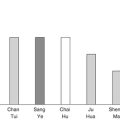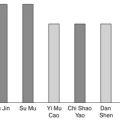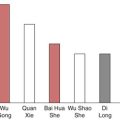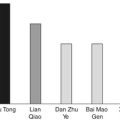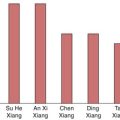Chapter Eight. Herbs that transform Phlegm
 |
1. What are the indications for herbs that transform Phlegm? What are visible Phlegm and invisible Phlegm?
Herbs that transform Phlegm are able to treat Phlegm syndrome. Phlegm is a kind of pathological product and it is also a secondary pathogenic factor, which will lead to further pathological changes in the body. Dysfunction of the Lung, Spleen, Kidney and San Jiao can result in accumulation of water. Meanwhile, in pathological conditions, Cold can condense water, Heat can consume water, and stagnation of Qi can obstruct the flow of water. Furthermore, the accumulated water becomes a kind of thick, sticky substance that is called ‘Phlegm’. Phlegm interferes with the normal flow of Qi and is also pushed by the Qi to spread through the body, so it may affect all parts of the body, with various manifestations.
Visible phlegm is often seen in clinical practice to accumulate in the Lung, and this can be expectorated. Coughing, wheezing and fullness or stifling feelings in the chest often exist because the Lung-Qi is obstructed.
There is also another kind of Phlegm that is neither visible nor able to be expectorated. This is the so-called ‘invisible Phlegm’. It can result in different symptoms when it stays in different parts of the body. When it accumulates in the Stomach, it may cause nausea, vomiting, loss of appetite, and fullness or distension in the upper abdomen. If it is pushed by rebellious rising Qi, then it moves upwards and disturbs the sensory orifices, and the patient experiences dizziness, vertigo, tinnitus and heavy sensations in the head. If the Phlegm obstructs the Heart and disturbs the Mind, it will cause palpitations, restlessness, insomnia, depression, mental confusion, delirium, mania, coma, Wind-stroke and epilepsy. If it obstructs the meridians and collaterals, and blocks the circulation of the Qi and Blood, then corresponding symptoms may occur in the locality. If in the chest, then chest pain and palpitations may be present; if on the face, there may be distortion of the mouth and the eyes; if in the limbs or the trunk, there will be sensations of numbness and heaviness. If Phlegm accumulates for a long period of time and is combined with other pathogenic factors, it can form masses, such as different kinds of tumor.
The most commonly used substances that transform Phlegm may remove visible Phlegm and are also able to disperse the Lung-Qi and direct it downwards; therefore they can stop coughing. Some of the substances are also able to remove invisible Phlegm; however, since the cause of invisible Phlegm is more complicated, in clinical practice they must be used together with other herbs that regulate the Qi, tonify the Spleen-Qi and transform Dampness to increase the therapeutic effects.
2. What are the characteristics of herbs that transform Phlegm? What precautions should be observed when they are used?
Herbs that transform Phlegm are used to treat Phlegm syndromes, which are caused by visible Phlegm and invisible Phlegm. These substances have the following characteristics.
Pungent and bitter
Pungency has dispersing and ascending properties; it has the ability to dissipate thick Phlegm. It is also able to disperse and lift the Qi so as to move the Phlegm. Bitterness has reducing and descending properties; it is able to descend the Qi and eliminate Phlegm. Pungent and bitter herbs have dispersing, ascending and descending capabilities, so they can dissipate thick Phlegm. Almost all the herbs that transform Phlegm have these characteristics.
Salty
Saltiness can soften hardness. Herbs that transform Phlegm with a salty taste are usually used for dissipating invisible Phlegm, which is characterized by a thick even hard nature, such as in chronic lymphadenitis, scrofula and tumors. The substances to treat this kind of Phlegm are Zhe Bei Mu ( Fritillariae thunbergii bulbus), Hai Zao ( Sargassum), Kun Bu ( Eckloniae thallus), Wa Leng Zi ( Arcae concha), Hai Ge Ke ( Meretricis/Cyclinae concha) and Meng Shi ( Lapis micae seu chloriti)*.
Cold or warm in temperature
Herbs that transform Phlegm are cold in temperature and are able to treat Phlegm-Heat syndrome. In this case, the Phlegm is thick, green, turbid and difficult to expectorate. In the syndrome caused by invisible Phlegm, there is mental confusion, a red tongue with a yellow, sticky coating, and a slippery and rapid pulse, which indicates the presence of Phlegm-Heat. The commonly used substances to eliminate Phlegm-Heat are Zhu Li ( Bambusae succus), Tian Zhu Huang ( Bambusae concretio silicea), Sang Bai Pi ( Mori cortex), Chuan Bei Mu ( Fritillariae cirrhosae bulbus), Gua Lou ( Trichosanthis fructus), Hai Zao, Kun Bu, Ting Li Zi ( Lepidii/Descurainiae semen), Hai Fu Shi ( Pumex) and Hai Ge Ke.
Substances that transform Phlegm that are warm in temperature are able to treat Cold-Phlegm syndrome, which is characterized by copious, white or watery sputum. The commonly used substances are Ban Xia ( Pinelliae rhizoma), Ju Hong ( Citri erythrocarpae pars rubra epicarpii), Xing Ren ( Armeniacae semen), Su Zi ( Perillae fructus), Tian Nan Xing ( Arisaematis rhizoma), Bai Fu Zi ( Typhonii rhizoma praeparatum)* and Bai Jie Zi ( Sinapis albae semen).
Entering the Lung and Large Intestine meridians
Herbs that enter the Lung and Large Intestine meridians treat mainly visible Phlegm. Besides eliminating Phlegm, most of them are able to stop a cough which is caused by Phlegm accumulation in the Lung and obstruction of the Lung-Qi. The commonly used herbs are Xing Ren, Jie Geng ( Platycodi radix), Chuan Bei Mu ( Fritillariae cirrhosae bulbus), Pi Pa Ye ( Eriobotryae folium), Qian Hu ( Peucedani radix), Bai Qian ( Cynanchi stauntonii radix), Zi Wan ( Asteris radix) and Kuan Dong Hua ( Tussilaginis farfarae).
Entering the Heart, Stomach, Liver and Gall Bladder meridians
Herbs that enter the Heart, Stomach, Liver and Gall Bladder meridians are able to remove invisible Phlegm. Invisible Phlegm might accumulate in the Stomach, cover the Mind or block the orifices. Invisible Phlegm obstructs the Qi movement and Blood circulation in these meridians and collaterals, causing different symptoms. The commonly used herbs for removing invisible Phlegm are Ban Xia, Zhu Ru ( Bambusae caulis in taeniam), Zhi Shi ( Aurantii fructus immaturus), Dan Nan Xing ( Pulvis arisaemae cum felle bovis), Bai Jie Zi, Bai Fu Zi*, Meng Shi*, Ting Li Zi, Hai Zao, Kun Bu and Hai Ge Ke.
Combining with herbs that transform Dampness and herbs that tonify the Spleen
Phlegm and Dampness are considered in TCM to be substances with the same nature and coming from the same origin. If the pathogen spreads without any form, it is called Dampness; if it accumulates in a particular place and becomes thick and turbid and has a shape, it is called Phlegm. Herbs that transform Phlegm and Dampness can be used together to increase the therapeutic effects of removing Phlegm.
The Spleen is responsible for transforming Dampness. If the Spleen-Qi is deficient, it fails to transport and transform water, and water can accumulate and form Phlegm. There is a saying: ‘The Lung is the receptacle of Phlegm and the Spleen is the organ of generating Phlegm.’ Herbs that tonify the Spleen-Qi are often used in treating Phlegm syndromes, especially in the chronic disorders.
Herbs that treat Phlegm have a pungent-warm, bitter-warm or pungent-cold nature, and they should be used with caution because pungent, warm and bitter herbs can consume the Yin, and cold herbs can injure the Yang if these herbs are used in large dosage and for a long period of time. Moreover, pregnant women should use these herbs with caution as the pungent and warm herbs can activate Qi and Blood, and the bitter herbs move downwards. These actions may bring danger to the pregnancy.
3. What are the functions and characteristics of Xing Ren ( Armeniacae semen) and Jie Geng ( Platycodi radix)?
Xin Ren and Jie Geng both enter the Qi level of the Lung meridian. Both are able to transform Phlegm from the Lung and stop coughing. In clinical practice, they are often used together to treat cold infections and bronchitis. With some other herbs, they can also treat pneumonia, asthma and pulmonary emphysema. However, these two herbs have their own characteristics and they carry out their functions by different methods.
Xing Ren is bitter, warm and slightly poisonous. The bitter taste gives Xing Ren a descending property. Warmth can disperse the accumulation of Phlegm and the stagnation of Qi. It is a kind of seed and it contains oil, which gives this herb a moist nature. The function of Xing Ren is characterized as descending the Lung-Qi and transforming Phlegm in order to stop coughing. It is particularly useful for treating cough with a large amount of Phlegm, fullness in the chest, shortness of breath and nasal obstruction when exterior pathogenic factors invade the Lung and the Lung-Qi fails to descend.
Jie Geng is pungent, bitter and neutral. It is able to transform Phlegm and stop coughing. The pungent and bitter tastes give Jie Geng dispersing and dissipating capacities. It is light both in weight and in nature; therefore its function is characterized as lifting the Lung-Qi gently but sufficiently. It is suitable for treating cough with Phlegm, stifling in the chest and nasal obstruction due to obstruction of the Lung-Qi.
Comparing Jie Geng and Xin Ren, one moves upwards, the other moves downwards; one disperses the Lung-Qi and the other directs the Lung-Qi to descend. They perfectly match each other to regulate the Lung-Qi, eliminate Phlegm and relieve cough. This is why they are often used together in clinical practice.
4. What are the characteristics of Jie Geng ( Platycodi radix)?
Jie Geng is bitter, pungent and neutral and enters the Lung meridian. It is light in nature and its function is characterized as ascending and dispersing the Lung-Qi. This feature gives Jie Geng not only the capability of dispersing the Lung-Qi so as to treat cough with Phlegm, but also the possibility of activating the Qi movement in the whole body in order to treat disorders of other organs and meridians. For instance, to treat constipation, or difficult bowel movement due to Qi stagnation in the intestine, besides using purging and descending herbs to stimulate the intestines and promote bowel movement, Jie Geng could also be used to lift the Lung-Qi so as to activate the Qi movement in the Large Intestine because the Lung and Large Intestine are Internally–Externally related. This combination is more effective than if only the descending herbs are used.
Another example is the treatment of difficult urination and edema due to water accumulation in the Lower or Middle Jiao. Besides using herbs that drain water and reduce water accumulation, Jie Geng could be used to disperse the Lung-Qi and open the Upper Jiao so as to accelerate the Qi and water movement in the Middle Jiao and Lower Jiao. The therapeutic result of this combination is also much better than if draining and reducing herbs are used alone. Since Jie Gen is a special herb for regulating the Qi through opening and lifting the Lung-Qi, it is described in the classics as ‘the oar of the boat’, which means that Jie Geng may assist the Qi movement in the opposite direction so as to break up various obstructions.
Because Jie Geng is light and ascending in nature and enters the Lung meridian, it is also very often used as a guide to enter the Lung meridian for herbs that do not enter this meridian. For example, in chronic diarrhea due to Spleen-Qi deficiency, patients may also have shortness of breath and weak voice due to Lung-Qi deficiency, and herbs that tonify the Spleen-Qi can easily enter the Lung as well to tonify the Lung-Qi if Jie Geng is used as a guide.
5. What are the differences between Bai Qian ( Cynanchi stauntonii radix) and Qian Hu ( Peucedani radix)?
Bai Qian and Qian Hu are often prescribed as ‘ Er Qian’, meaning ‘the two Qian’, which suggests that these two herbs are often used together. Both are pungent and enter the Lung meridian and are effective for relieving cough. The pungent property gives them the capability of dispersing the Lung-Qi. Meanwhile, the direction of their action is downward; they can effectively descend the Lung-Qi and relieve cough. Both are used for treating fullness in the chest, productive cough and wheezing due to obstruction of the Lung-Qi. They can also be used to treat External syndrome because they are pungent and are able to expel Wind. However, there are some differences between these two herbs, so they can also be used separately in different conditions.
Bai Qian is a warm herb and its action of descending the Lung-Qi is stronger than that of Qian Hu. It is suitable for treating cough, wheezing, asthma and white sputum, which is difficult to expectorate and causes stifling feelings in the chest. Qian Hu is cold in nature and is more suitable for clearing Heat in the Lung and treating cough with green and thick sputum, a sense of constriction in the chest and irritability.
6. What are the differences between Zi Wan ( Asteris radix), Kuan Dong Hua ( Tussilaginis farfarae) and Bai Bu ( Stemonae radix) in relieving cough and transforming Phlegm?
These three herbs all enter the Lung meridian. They have a similar function in moistening the Lung, descending the Lung-Qi, transforming Phlegm and relieving cough. All are warm, pungent and bitter, but they have no drying property and can be used for treating many kinds of cough caused by Exterior or Interior pathogenic factors. They treat cough either in the acute stage or in chronic stages, in Excess or Deficiency syndromes, and in Hot or Cold syndromes. Because of these characteristics, they are widely used in clinical practice. They are often used together to treat bronchitis, pneumonia, upper respiratory tract infection and pertussis.
However, comparing the functions of the three herbs, Zi Wan is the strongest one for transforming Phlegm, Kuan Dong Hua is the most effective one for relieving cough and Bai Bu is the most commonly used to treat chronic cough.
7. What are the differences between Chuan Bei Mu ( Fritillariae cirrhosae bulbus) and Zhe Bei Mu ( Fritillariae thunbergii bulbus)?
Chuan Bei Mu and Zhe Bei Mu are bitter and cold, and enter the Lung and Heart meridians. Both can transform Phlegm-Heat, dissipate nodules and treat cough with thick, green sputum that is difficult to expectorate, with dryness in the mouth and nasal cavity. However, they also have their own characteristics.
Chuan Bei Mu is sweet and is less cold than Zhe Bei Mu. Sweetness combined with coldness can generate Yin of the body. This herb is characterized as moistening the Lung, transforming Phlegm and relieving cough. It is effective for treating Phlegm-Heat syndrome with signs of Lung-Yin or Body Fluid deficiency. The symptoms are very sticky and thick sputum, in small amounts, that is difficult to expectorate, or cough without production, dryness in the throat and nasal cavity, chronic cough, paroxysmal cough, cough without Phlegm, stifling in the chest and hypochondriac pain. Together with herbs that nourish the Yin of the body, Chuan Bei Mu is used for treating chronic or acute bronchitis, pneumonia, lung abscess, asthma and tuberculosis. Since it has the function of dissipating thick Phlegm and dispersing constrained Qi in the chest, if combined with herbs that spread the Liver-Qi it can treat depression, ‘plum-pit syndrome’, pulmonary tuberculosis and nodules.
Zhe Bei Mu is more bitter and colder than Chuan Bei Mu. It has no function in moistening the Lung, but is stronger than Chuan Bei Mu in clearing Heat and reducing Fire. It is also stronger for breaking up congealed Phlegm and is therefore more suitable for treating Phlegm-Heat in the Lung. The manifestations are very sticky sputum, which is difficult to expectorate, a very red tongue with a yellow sticky coating and a slippery and rapid pulse. This herb is also stronger for dissipating nodules than Chuan Bei Mu and it is used to treat red, swollen and painful scrofula or abscesses. Combined with other herbs, it is used to treat tumors.
8. What are the differences between Gua Lou ( Trichosanthis fructus), Gua Lou Ren ( Trichosanthis semen), Gua Lou Pi ( Trichosanthis pericarpium) and Gua Lou Gen ( Trichosanthis radix)
These four herbs are from different parts of the same plant, and there are some differences between their functions too.
Gua Lou and Gua Lou Ren are sweet, bitter and cold. They enter the Lung, Stomach and Large Intestine meridians. Both can clear Heat from the Lung, transform Phlegm-Heat and unbind the Qi in the chest. They can treat cough with a large amount of green sputum, distension, constriction and pain in the chest and irritability. In clinical practice, they can be used for treating bronchitis, pneumonia, lung abscess and breast abscess. They also have the function of promoting bowel movement and treating constipation, especially when there is Phlegm-Heat in the Lung.
Comparing the functions of the two herbs, Gua Lou is stronger in the function of clearing Heat and transforming Phlegm; Gua Lou Ren is stronger in moistening the intestine and promoting bowel movement. If combined with herbs that clear Heat, Gua Lou Ren is effective for removing Phlegm-Heat from the intestine and treating colitis and dysentery.
Gua Lou Pi is sweet and cold. It has a similar function to Gua Lou and Gua Lou Ren in transforming Phlegm in the Lung but it is not as strong as the other two in clearing Heat. This herb is characterized as moistening the Lung and throat; therefore it can treat a hoarse, sore throat and thirst due to Dryness in the Lung.
Gua Lou Gen is also called Tian Hua Fen. It has a quite different function from that of the other herbs. It is bitter, sour, cold and slightly sweet, and enters the Lung and Stomach meridians. It has no function of transforming Phlegm, but it can clear Heat from the Lung, generate the Body Fluids and alleviate thirst. In clinical practice, it is used to treat diabetes. It is also able to relieve Heat-toxin and treat sore throat, pneumonia, lung abscess, breast abscess, carbuncles and sores.
9. What are the differences between Tian Zhu Huang ( Bambusae concretio silicea), Zhu Li ( Bambusae succus) and Zhu Ru ( Bambusae caulis in taeniam)?
These three herbs come from bamboo. They are sweet and cold, and have the functions of clearing Heat and transforming Phlegm. However, the three enter different meridians and their strengths are different also, so their clinical applications are different too.
Tian Zhu Huang enters the Heart and Liver meridians, and is effective for dislodging Phlegm, clearing Heat, cooling the Heart and controlling convulsions. It is often used in children when there is high fever, irritability, convulsions and night crying caused by disturbance of the Heart and Liver by Phlegm-Heat. It can also be used to treat fever, shortness of breath and cough with thick sputum in conditions of Phlegm-Heat in the Lung. In clinical practice, it is used for convulsions in infectious diseases, pneumonia, acute bronchitis and influenza.
Zhu Li is the coldest of these three herbs. It enters the Heart, Lung and Stomach meridians. It has a lubricating nature and its function is characterized as strongly eliminating Phlegm-Heat, especially when Phlegm blocks the meridians and collaterals; therefore it is used to treat epilepsy, hemiplegia, facial paralysis, and numbness and tingling or cramp of the limbs. It is also able to open the Heart orifice, and is used when Phlegm-Heat covers the Heart. In this situation, patients lose consciousness and have gurgling sounds in the throat, such as in epilepsy, cerebrovascular accident and myocardial infarction. Zhu Li is also often used for treating mental disorders when Phlegm-Heat covers or disturbs the Mind, such as in schizophrenia.
Zhu Ru is slightly cold, and enters the Lung, Stomach and Gall Bladder meridians. Besides clearing Heat and transforming Phlegm, it is effective for dispersing constrained Qi, eliminating irritability and calming the Mind. It is mainly used for treating restlessness, palpitations, restless sleep, depression and aprosexia, especially after febrile disease or in chronic disease. It is also effective for soothing the Stomach-Qi, clearing Heat and treating nausea and vomiting—for example, in morning sickness of early pregnancy, heatstroke, migraine and Ménière’s disease.
10. Ting Li Zi ( Lepidii/Descurainiae semen), Sang Bai Pi ( Mori cortex) and Xuan Fu Hua ( Inulae flos) are able to direct the Lung-Qi to descend, transform Phlegm and arrest wheezing. What are the differences between their actions?
Ting Li Zi and Sang Bai Pi are cold herbs and enter the Lung meridian. They are able to direct the Lung-Qi downwards, and eliminate Phlegm and water accumulation, thereby reducing obstruction of the Lung-Qi and arresting wheezing. They are used together in clinical practice to treat cough, asthma, fullness in the chest, edema and difficult urination.
Ting Li Zi is very pungent, bitter and cold, and is much stronger than Sang Bai Pi in directing the Lung-Qi downwards and draining water. It is therefore considered to be an agent that drives out water and Phlegm. It also enters the Large Intestine meridian, and can drain Heat, water and Phlegm via bowel movement. It is more suitable for treating the Excess syndromes of Phlegm and water accumulation in the Lung. In these syndromes, the Lung-Qi is obstructed, so the Qi movement is blocked in the San Jiao, Bladder and Large Intestine meridians, such as in asthma, pleuritis, pulmonary heart disease, heart failure, acute nephritis and renal failure. However, since Ting Li Zi is a harsh and cold herb and easily injures the Qi, it is used in Excessive syndromes for only a short time.
Sang Bai Pi is sweet, bland and cold. Coldness can clear Heat, blandness can leach out Dampness, and sweetness can protect the Lung. Sang Bai Pi is gentler than Ting Li Zi in directing the Qi downwards and eliminating the accumulation of water and Phlegm, so it has fewer side-effects and can be used for a longer period of time. In clinical practice, it is often used for treating acute bronchitis, pneumonia, upper respiratory infection and acute nephritis.
Xuan Fu Hua is also able to direct the Qi downwards from the Lung and eliminate Phlegm, relieve cough and arrest wheezing, but it is warm in nature and is more suitable for treating syndromes in which the Lung-Qi is obstructed by accumulation of Cold-Phlegm. Meanwhile, like Ting Li Zi and Sang Bai Pi, Xuan Fu Hua can also leach out water, but its function is a result of directing the Lung-Qi downwards. It is more effective for transforming Phlegm and so is used as an agent especially for dissolving Phlegm. In addition, this herb is also very effective for descending the Stomach-Qi and relieving nausea and vomiting. In clinical practice, Xuan Fu Hua is used for treating bronchitis, pulmonary emphysema, bronchiectasis and acute gastritis.
11. What are the functions of Ban Xia ( Pinelliae rhizoma)? What are the characteristics of processed Ban Xia?
Ban Xia is warm, pungent and poisonous, and it enters the Spleen and Stomach meridians. It is able to dry Dampness and transform Phlegm in the Middle Jiao. When the Dampness is removed, the transportation function of the Spleen is restored, and Phlegm is no longer generated. In clinical practice, Ban Xia is able to treat chronic bronchitis, pulmonary emphysema, and cold and influenza infections with symptoms of coughing up a large amount of white sputum and tightness in the chest. Ban Xia is also very effective for soothing the Stomach-Qi and transforming Damp-Phlegm in the Stomach so as to treat nausea, vomiting, reduced appetite and fullness in the epigastric region; in clinical practice it is used to treat gastritis, anorexia and morning sickness.
However, as raw Ban Xia is poisonous, this herb is often used after processing. There are several processed forms of Ban Xia that are often prescribed, as follows.
Qing Ban Xia, the light Ban Xia
After raw Ban Xia is soaked and rinsed in water until the hot taste is removed, it is cooked with alum. It is then dried and cut in pieces. Qing Ban Xia is warm and pungent, and has a drying nature. It is more suitable for treating Damp-Phlegm accumulation in the Lung, which manifests as coughing with a large amount of sputum, tightness in the chest and nausea.
Jiang Ban Xia, the ginger-processed Ban Xia
After the hot taste is removed by soaking and rinsing in water, Ban Xia is cooked with ginger and alum. It is then dried before being used. Jiang Ban Xia is better at soothing the Stomach-Qi and relieving nausea and vomiting caused by Cold in the Stomach.
Fa Ban Xia, the standard-processed Ban Xia
After the hot taste is removed by soaking and rinsing in water, Ban Xia is soaked with Gan Cao (Radix Glycyrrhizae) and lime. It is dried and crushed before it is used. Fa Ban Xia is particularly effective for drying Dampness in the Middle Jiao and promoting the function of the Spleen and Stomach. It is used to treat fullness in the epigastric region, poor appetite, loose stools, heaviness of the body and tiredness.
Ban Xia Qu, the fermented Ban Xia
After the hot taste is removed by soaking and rinsing in water, Ban Xia is ground and mixed with wheat powder and ginger juice. A dough is made which is then cut into small pieces. After it has fermented, it is dried before being used. Ban Xia Qu is better for strengthening the function of the Stomach and Spleen and promoting digestion. It is used for treating poor appetite, indigestion and a weak constitution.
12. What are the differences between Tian Nan Xing ( Arisaematis rhizoma) and processed Nan Xing?
Tian Nan Xing is the name of the raw herb. Because the raw herb is poisonous, it is often used after processing. Zhi Nan Xing and Dan Nan Xing are two kinds of commonly used processed products of this herb.
After soaking in alum solution, the herb is rinsed until the hot taste is removed, cooked with fresh ginger, and later dried. The product is called Zhi Nan Xing; this form is pungent, bitter and warm, and enters the Lung, Spleen and Liver meridians. It has a very strong dispersing ability and can intensively dry Dampness, dissolve Damp-Phlegm, treat tightness in the chest and expectorate a large amount of white sputum. It is able to eliminate invisible Phlegm from meridians and collaterals and is used for syndromes of Wind-Phlegm obstruction in the meridians, which manifests as numbness, heaviness and tingling of the limbs, such as in fibrositis, arthritis, facial paralysis and facial spasm.
When the powder of Tian Nan Xing is mixed with bovine bile, it is called Dan Nan Xing ( Pulvis arisaemae cum felle bovis). Dang Nan Xing is more bitter than Zhi Nan Xing as the pungent and warm nature has been changed to cold and moist. It is characterized as clearing Heat, expelling Phlegm, extinguishing Wind and calming spasm. It can effectively treat cough without production, or scanty green sputum that is difficult to expectorate. It is also able to eliminate invisible Phlegm and treat epilepsy and Wind-stroke, which are caused by Phlegm-Heat covering the Heart.
Although Tian Nan Xing, the raw herb, is poisonous, it is also used in clinical practice. It is very pungent and warm, and is mainly used topically to dissipate congealed blood, reduce swelling and stop pain. It can treat sores, ulcers, carbuncles and trauma.
13. What are the differences between Hai Zao ( Sargassum) and Kun Bu ( Eckloniae thallus)?
Hai Zao and Kun Bu are salty and cold, and enter the Liver, Lung and Kidney meridians. Both can clear Heat, transform Phlegm, soften hardness and dissipate nodules. They can also promote urination and reduce edema. In clinical practice, they are often used together to treat nodules such as goiter and scrofula.
There are some differences between the two herbs. Hai Zao is stronger in transforming Phlegm and dissipating nodules; it is more suitable for treating goiter and scrofula. Kun Bu is stronger in softening hardness and reducing the congealed Blood; it is more suitable for treating hepatosplenomegaly, liver cirrhosis and tumors.
14. Which herbs are particularly effective for relieving cough?
The herbs that are particularly effective for relieving cough are able to disperse or descend the Lung-Qi. If they are combined with herbs that transform Phlegm, clear Heat or expel Cold, they can be used for treating an acute or chronic cough in Excess or Deficiency syndromes, or for treating a cough caused by Cold or Heat in the Lung. These herbs can be divided into two groups according to whether they have warm or cold temperatures.
Herbs that relieve cough and are cold in temperature are particularly used when Heat accumulates in the Lung. The commonly used ones are Qian Hu ( Peucedani radix), Chuan Bei Mu ( Fritillariae cirrhosae bulbus), Pi Pa Ye ( Eriobotryae folium), Sang Ye ( Mori folium) and Sang Bai Pi ( Mori cortex).
Herbs that relieve cough and are warm in temperature are used when there is no obvious Heat in the Lung, and most are also effective for transforming Phlegm. The commonly used ones are Ju Hong ( Citri erythrocarpae pars rubra epicarpii), Xing Ren ( Armeniacae semen), Jie Geng ( Platycodi radix), Bai Qian ( Cynanchi stauntonii radix), Zi Wan ( Asteris radix), Kuan Dong Hua ( Tussilaginis farfarae) and Bai Bu ( Stemonae radix).
15. Which herbs are able to clear Heat and transform Phlegm from the Lung?
The herbs that clear Heat and transform Phlegm from the Lung are Zhe Bei Mu ( Fritillariae thunbergii bulbus), Chuan Bei Mu ( Fritillariae cirrhosae bulbus), Gua Lou ( Trichosanthis fructus), Dan Nan Xing ( Pulvis arisaemae cum felle bovis), Hai Fu Shi ( Pumex) and Hai Ge Ke ( Meretricis/Cyclinae concha).
These herbs are particularly effective for treating cough with green, thick sputum that is difficult to expectorate, tightness in the chest, quick breathing, a red tongue with a thick, yellow coating and a rapid and slippery pulse. In clinical practice, these herbs are often used for treating upper respiratory tract infection, acute bronchitis and pneumonia.
These herbs are also often used together with other herbs to treat certain diseases of the Lung. For example, if combined with Shi Gao ( Gypsum), Huang Qin ( Scutellariae radix), Jin Yin Hua ( Lonicerae flos) and Lian Qiao ( Forsythiae fructus), they can reduce Heat from the Lung and relieve Fire-toxin so as to control infections of the Lung. If combined with Lu Gen ( Phragmitis rhizoma), Jie Geng ( Platycodi radix), Yi Yi Ren ( Coicis semen) and Yu Xing Cao ( Houttuyniae herba cum radice), they can treat lung abscess and sinusitis.
16. Which herbs are able to moisten the Lung and loosen sputum?
The herbs that moisten the Lung and loosen sputum are Chuan Bei Mu ( Fritillariae cirrhosae bulbus), Gua Lou ( Trichosanthis fructus), Pi Pa Ye ( Eriobotryae folium), Xing Ren ( Armeniacae semen), Bai He ( Lilii bulbus), Hai Fu Shi ( Pumex) and Hai Ge Ke ( Meretricis/Cyclinae concha).
These herbs are particularly suitable for treating cough without production or with scanty sputum that is difficult to expectorate, and dryness in the nasal cavity, mouth and throat. In some cases, chest pain and difficult breathing are present. The tongue is red with a thin dry, yellow coating, or with no coating, and the pulse is rapid and thready. These suggest that Heat has accumulated in the Lung and the Body Fluids have been consumed.
These herbs are often used for treating upper respiratory infection, acute or chronic bronchitis, pulmonary tuberculosis, pneumonia, influenza, pertussis, pharyngitis, spontaneous pneumothorax, cor pulmonale and silicosis. In order to increase the therapeutic result, these herbs are often used together with herbs that moisten the Lung and nourish the Lung-Yin—for example, Sang Ye ( Mori folium), Tian Hua Fen ( Trichosanthis radix), Bei Sha Shen ( Glehniae radix), Nan Sha Shen ( Adenophorae radix) and Mai Men Dong ( Ophiopogonis radix).
17. Which herbs are able to transform Damp-Phlegm?
The herbs that transform Damp-Phlegm are Ban Xia ( Pinelliae rhizoma), Ju Hong ( Citri erythrocarpae pars rubra epicarpii), Chen Pi ( Citri reticulatae pericarpium), Xing Ren ( Armeniacae semen), Jie Geng ( Platycodi radix), Zi Wan ( Asteris radix), Bai Qian ( Cynanchi stauntonii radix), Xuan Fu Hua ( Inulae flos) and Bai Jie Zi ( Sinapis albae semen).
These herbs are particularly effective for treating cough with a large amount of white, thin sputum, fullness in the chest and epigastrium, heavy and cold limbs, tiredness, a white, thick tongue coating and a slippery pulse. They are often used for treating chronic bronchitis, pulmonary emphysema, and cold and influenza infections.
In clinical practice, in order to increase the therapeutic effect to treat the cause of Phlegm, these herbs are often used together with herbs that transform Dampness, such as Fu Ling ( Poria) and Cang Zhu ( Atractylodis rhizoma), herbs that strengthen the function of the Spleen, such as Bai Zhu ( Atractylodis macrocephalae rhizoma), and herbs that warm the Interior, such as Sheng Jiang ( Zingiberis rhizoma recens).
18. Which herbs are able to disperse the Lung-Qi and direct it to descend, and arrest wheezing?
The herbs that particularly disperse the Lung-Qi and water accumulation and arrest wheezing are Ma Huang ( Ephedrae herba)*, She Gan ( Belamcandae rhizoma), Xing Ren ( Armeniacae semen) and Jie Geng ( Platycodi radix). They are often used together with herbs that move upwards, such as Xiang Ru ( Moslae herba), Jing Jie ( Schizonepetae herba) and Cang Zhu ( Atractylodis rhizoma).
Herbs that mainly direct the Lung-Qi to descend, reduce the accumulation of Phlegm and water and arrest wheezing are Bai Qian ( Cynanchi stauntonii radix), Xing Ren ( Armeniacae semen), Su Zi ( Perillae fructus), Xuan Fu Hua ( Inulae flos), Ting Li Zi ( Lepidii/Descurainiae semen) and Sang Bai Pi ( Mori cortex). They are often used together with herbs that move downwards, such as Shi Gao ( Gypsum), Ban Xia ( Pinelliae rhizoma) and Chen Xiang ( Aquilariae lignum).
These herbs are particularly suitable for treating wheezing, shallow and quick breathing, coughing with watery sputum, stifling sensations in the chest, edema and difficult urination. In most cases, there is also a purple tongue with a watery coating, and a rapid, restless pulse. In clinical practice, these herbs are often used to treat asthma, pulmonary emphysema, chronic bronchitis, pulmonary heart disease with heart failure, acute nephritis and renal failure.
19. Which herbs are able to soothe the Stomach-Qi, and transform Phlegm and Dampness in the Stomach?
The herbs that soothe the Stomach-Qi and transform Damp-Phlegm are Ban Xia ( Pinelliae rhizoma), Xuan Fu Hua ( Inulae flos), Su Zi ( Perillae fructus), Zi Su Ye ( Perillae folium) and Pi Pa Ye ( Eriobotryae folium).
The herbs that soothe the Stomach-Qi and transform Phlegm-Heat and Damp-Heat in the Stomach are Zhu Ru ( Bambusae caulis in taeniam) and Huang Qin ( Scutellariae radix).
All of these herbs are able to relieve nausea, vomiting, fullness in the epigastric region, reduced appetite and distension in the abdomen. In most cases, patients have a sticky tongue coating and a rapid, wiry or slippery pulse. In clinical practice, these herbs can be used in the treatment of acute gastritis, hepatitis, morning sickness in early pregnancy, kinetosis, influenza and cold infections, depression, neurosis, anorexia, Ménière’s disease and migraine.
20. What are the symptoms and pathogenic changes in the syndrome when Phlegm covers the Mind? What are the commonly used substances to treat this disorder?
Phlegm and Phlegm-Heat may disturb or cover the Heart and cause mental disorders. The syndrome can be subdivided into Yin and Yang types. In the Yin type, the patient is quite dull, has hallucinations, murmurs to him or herself, sometimes cries and sometimes laughs, and has a poor appetite, a white sticky tongue coating and a wiry, slippery pulse. In clinical practice, this syndrome can be seen in depression, phobia, schizophrenia and other mental disorders. The syndrome is often caused by stagnation of the Liver-Qi and Spleen-Qi from disturbance of emotions such as worry, distress and sorrow. When Phlegm combines with the stagnant Liver-Qi, it may cover or disturb the Heart. The treatment principle in this condition is to promote the Qi movement and transform Phlegm. The commonly used herbs are Ban Xia ( Pinelliae rhizoma), Chen Pi ( Citri reticulatae pericarpium), Shi Chang Pu ( Acori graminei rhizoma), Yuan Zhi ( Polygalae radix) and Fu Ling ( Poria).
In the Yang type, the manifestations are mental confusion, delirium, mania and excitability, a red tongue with a yellow, sticky coating, and a wiry, slippery and rapid pulse. This syndrome often occurs in patients who have a Yang constitution or are in a condition of Phlegm-Heat; under the influence of violent rage, the Liver-Fire rises up quickly, also pushing Phlegm upwards and covering the Mind. In clinical practice, this syndrome can be found in many kinds of mental disorder such as mania, schizophrenia and in acute cerebrovascular accident. The treatment principle is to transform Phlegm-Heat and to open the Heart orifice. The commonly used herbs are Dan Nan Xing ( Pulvis arisaemae cum felle bovis), Zhu Ru ( Bambusae caulis in taeniam), Zhu Li ( Bambusae succus), Tian Zhu Huang ( Bambusae concretio silicea), Yu Jin ( Curcumae radix), Zhi Shi ( Aurantii fructus immaturus) and Meng Shi ( Lapis micae seu chloriti)*.
21. Which herbs are able to transform Wind-Phlegm from the meridians and collaterals?
The herbs that transform Wind-Phlegm are Tian Nan Xing ( Arisaematis rhizoma), Bai Fu Zi ( Typhonii rhizoma praeparatum)*, Bai Jie Zi ( Sinapis albae semen), Jiang Can ( Bombyx batrycatus), Tian Ma ( Gastrodiae rhizoma)**, Ban Xia ( Pinelliae rhizoma), Zhu Li ( Bambusae succus) and Tian Zhu Huang ( Bambusae concretio silicea).
These herbs are used in clinical practice to treat cramp, numbness, tingling, heaviness and pain in the limbs, facial paralysis, facial spasm, epilepsy, hemiplegia, migraine, neuralgia and arthritis. They are often used together with herbs that regulate the Qi and Blood, expel Wind-Dampness and extinguish internal Wind.
22. Which herbs are able to soften hardness and dissipate nodules?
The herbs that soften hardness and dissipate nodules are Hai Zao ( Sargassum), Kun Bu ( Eckloniae thallus), Hai Fu Shi ( Pumex), Hai Ge Ke ( Meretricis/Cyclinae concha), Wa Leng Zi ( Arcae concha) and Zhe Bei Mu ( Fritillariae thunbergii bulbus). They are used together with some other herbs which also have the function of softening hardness and dissipating nodules, such as Mu Li ( Ostrea concha), Huang Yao Zi ( Dioscoreae bulbiferae rhizoma), Xia Ku Cao ( Prunellae spica) and Xuan Shen ( Scrophulariae radix).
In clinical practice they are used in the treatment of cervical lymphadenopathy, lymphadenitis, thyroiditis, simple goiter and tumors. In order to increase the therapeutic effects, they are often combined with herbs that regulate the Qi and Blood and reduce Heat-toxin.
Comparisons of strength and temperature in herbs that transform Phlegm
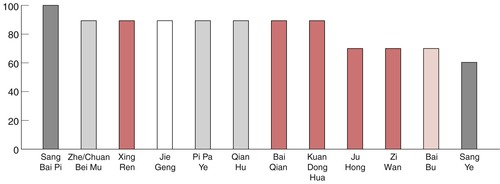 |
| Fig. 8.1. |
| Comparison of the herbs that relieve coughing. Sang Bai Pi ( Mori cortex), Zhe/Chuan Bei Mu ( Fritillariae thunbergii bulbus/Fritillariae cirrhosae bulbus), Xing Ren ( Armeniacae semen), Jie Geng ( Platycodi radix), Pi Pa Ye ( Eriobotryae folium), Qian Hu ( Peucedani radix), Bai Qian ( Cynanchi stauntonii radix), Kuan Dong Hua ( Tussilaginis farfarae), Ju Hong ( Citri erythrocarpae pars rubra epicarpii), Zi Wan ( Asteris radix), Bai Bu ( Stemonae radix), Sang Ye ( Mori folium). |
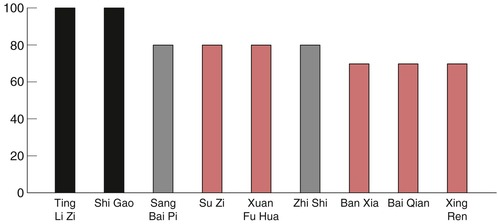 |
| Fig. 8.2. |
| Comparison of the herbs that direct the Lung-Qi to descend and relieve wheezing. Ting Li Zi ( Lepidii/Descurainiae semen), Shi Gao ( Gypsum), Sang Bai Pi ( Mori cortex), Su Zi ( Perillae fructus), Xuan Fu Hua ( Inulae flos), Zhi Shi ( Aurantii fructus immaturus), Ban Xia ( Pinelliae rhizoma), Bai Qian ( Cynanchi stauntonii radix), Xing Ren ( Armeniacae semen). |
 |
| Fig. 8.3. |
| Comparison of the herbs that dissolve Phlegm, relieve coughing and are warm in temperature. Bai Jie Zi ( Sinapis albae semen), Xuan Fu Hua ( Inulae flos), Su Zi ( Perillae fructus), Tian Nan Xing ( Arisaematis rhizoma), Ban Xia ( Pinelliae rhizoma), Ju Hong ( Citri erythrocarpae pars rubra epicarpii), Bai Qian ( Cynanchi stauntonii radix), Zi Wan ( Asteris radix), Xing Ren ( Armeniacae semen). |
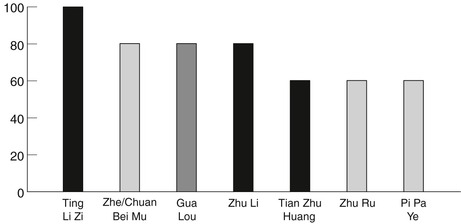 |
| Fig. 8.4. |
| Comparison of the herbs that dissolve Phlegm, relieve coughing and are cold in temperature. Ting Li Zi ( Lepidii/Descurainiae semen), Zhe/Chuan Bei Mu ( Fritillariae thunbergii bulbus/Fritillariae cirrhosae bulbus), Gua Lou ( Trichosanthis fructus), Zhu Li ( Bambusae succus), Tian Zhu Huang ( Bambusae concretio silicea), Zhu Ru ( Bambusae caulis in taeniam), Pi Pa Ye ( Eriobotryae folium). |
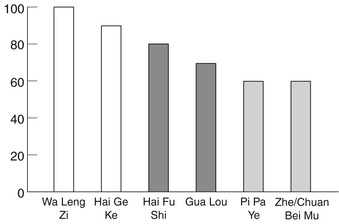 |
| Fig. 8.5. |
| Comparison of the substances that dissolve thick sputum. Wa Leng Zi ( Arcae concha), Hai Ge Ke ( Meretricis/Cyclinae concha), Hai Fu Shi ( Pumex), Gua Lou ( Trichosanthis fructus), Pi Pa Ye ( Eriobotryae folium), Zhe/Chuan Bei Mu ( Fritillariae thunbergii bulbus/Fritillariae cirrhosae bulbus). |
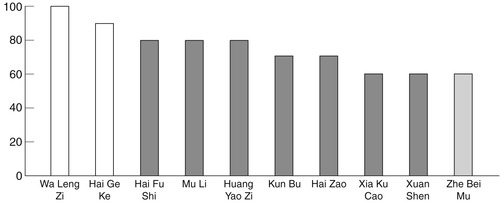 |
| Fig. 8.6. |
| Comparison of the substances that eliminate Phlegm and soften hardness. Wa Leng Zi ( Arcae concha), Hai Ge Ke ( Meretricis/Cyclinae concha), Hai Fu Shi ( Pumex), Mu Li ( Ostrea concha), Huang Yao Zi ( Dioscoreae bulbiferae rhizoma), Kun Bu ( Eckloniae thallus), Hai Zao ( Sargassum), Xia Ku Cao ( Prunellae spica), Xuan Shen ( Scrophulariae radix), Zhe Bei Mu ( Fritillariae thunbergii bulbus). |
 |
| Fig. 8.7. |
| Comparison of the herbs that eliminate invisible Wind-Phlegm. Bai Fu Zi ( Typhonii rhizoma praeparatum)*, Bai Jie Zi ( Sinapis albae semen), Zhu Li ( Bambusae succus), Tian Nan Xing ( Arisaematis rhizoma), Tian Ma ( Gastrodiae rhizoma)**, Ban Xia ( Pinelliae rhizoma), Tian Zhu Huang ( Bambusae concretio silicea), Jiang Can ( Bombyx batrycatus). |
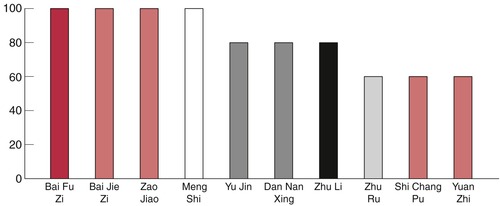 |
| Fig. 8.8. |
| Comparison of the substances that eliminate invisible Phlegm and open the orifices. Bai Fu Zi ( Typhonii rhizoma praeparatum)*, Bai Jie Zi ( Sinapis albae semen), Zao Jiao ( Gleditsiae fructus), Meng Shi ( Lapis micae seu chloriti)*, Yu Jin ( Curcumae radix), Dan Nan Xing ( Pulvis arisaemae cum felle bovis), Zhu Li ( Bambusae succus), Zhu Ru ( Bambusae caulis in taeniam), Shi Chang Pu ( Acori graminei rhizoma), Yuan Zhi ( Polygalae radix). |

